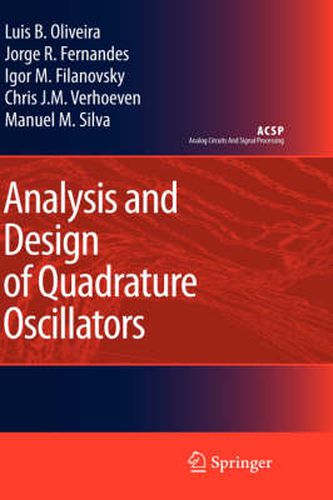Readings Newsletter
Become a Readings Member to make your shopping experience even easier.
Sign in or sign up for free!
You’re not far away from qualifying for FREE standard shipping within Australia
You’ve qualified for FREE standard shipping within Australia
The cart is loading…






This title is printed to order. This book may have been self-published. If so, we cannot guarantee the quality of the content. In the main most books will have gone through the editing process however some may not. We therefore suggest that you be aware of this before ordering this book. If in doubt check either the author or publisher’s details as we are unable to accept any returns unless they are faulty. Please contact us if you have any questions.
Modern RF receivers and transmitters require quadrature oscillators with accurate quadrature and low phase-noise. Existing literature is dedicated mainly to single oscillators, and is strongly biased towards LC oscillators. This book is devoted to quadrature oscillatorsand presents adetailed comparative study ofLC and RCosc- lators, both at architectural and at circuit levels. It is shown that in cross-coupled RC oscillators both the quadrature error and phase-noise are reduced, whereas in LC - cillators the coupling decreases the quadrature error, but increases the phase-noise. Thus, quadrature RC oscillators can be a practical alternative to LC oscillators, - pecially when area and cost are to be minimized. The main topics of the book are: cross-coupled LC quasi-sinusoidal oscillators, cross-coupled RC relaxation oscillators, a quadrature RC oscillator-mixer, and t- integrator oscillators. The effect of mismatches on the phase-error and the pha- noise are thoroughly investigated. The book includes many experimental results, obtained from different integrated circuit prototypes, in the GHz range. A structured design approach is followed: a technology independent study, with ideal blocks, is performed initially, and then the circuit level design is addressed. This book can be used in advanced courses on RF circuit design. In addition to post-graduate students and lecturers, this book will be of interest to design engineers and researchers in this area.
$9.00 standard shipping within Australia
FREE standard shipping within Australia for orders over $100.00
Express & International shipping calculated at checkout
This title is printed to order. This book may have been self-published. If so, we cannot guarantee the quality of the content. In the main most books will have gone through the editing process however some may not. We therefore suggest that you be aware of this before ordering this book. If in doubt check either the author or publisher’s details as we are unable to accept any returns unless they are faulty. Please contact us if you have any questions.
Modern RF receivers and transmitters require quadrature oscillators with accurate quadrature and low phase-noise. Existing literature is dedicated mainly to single oscillators, and is strongly biased towards LC oscillators. This book is devoted to quadrature oscillatorsand presents adetailed comparative study ofLC and RCosc- lators, both at architectural and at circuit levels. It is shown that in cross-coupled RC oscillators both the quadrature error and phase-noise are reduced, whereas in LC - cillators the coupling decreases the quadrature error, but increases the phase-noise. Thus, quadrature RC oscillators can be a practical alternative to LC oscillators, - pecially when area and cost are to be minimized. The main topics of the book are: cross-coupled LC quasi-sinusoidal oscillators, cross-coupled RC relaxation oscillators, a quadrature RC oscillator-mixer, and t- integrator oscillators. The effect of mismatches on the phase-error and the pha- noise are thoroughly investigated. The book includes many experimental results, obtained from different integrated circuit prototypes, in the GHz range. A structured design approach is followed: a technology independent study, with ideal blocks, is performed initially, and then the circuit level design is addressed. This book can be used in advanced courses on RF circuit design. In addition to post-graduate students and lecturers, this book will be of interest to design engineers and researchers in this area.